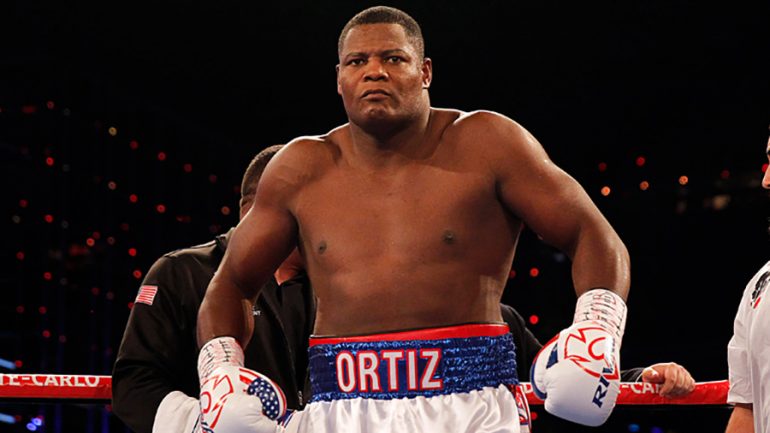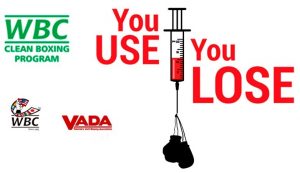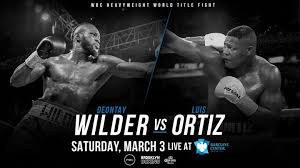Wilder-Ortiz and the PED Shadow

Last year, in an article entitled “Congratulations to the WBC and VADA”, I praised the World Boxing Council and Voluntary Anti-Doping Association for their stand against the use of performance enhancing drugs in boxing. The article was written after the WBC withdrew its sanction of a scheduled November 4, 2017, title fight between Deontay Wilder and Luis Ortiz in the wake of Ortiz testing positive for chlorothiazide and hydrochlorothiazide, banned diuretics that are sometimes used to treat high blood pressure but are also used to mask performance-enhancing drugs.
The test was administered by VADA as part of the WBC Clean Boxing Program.
VADA is still in the forefront of the fight against the use of illegal performance enhancing drugs in boxing. Last week, the Boxing Writers Association of America announced that it was honoring VADA founder and president Dr. Margaret Goodman with the Barney Nagler Award for Long and Meritorious Service to Boxing.
But the WBC has sent ambiguous signals recently regarding the scope of its commitment to VADA.
Meanwhile, Wilder-Ortiz has been rescheduled for March 3 at Barclays Center in Brooklyn. And the New York State Athletic Commission, which has jurisdiction over the bout, has taken steps to date that bring the enforcement of New York’s rules and regulations regarding illegal PED use into question.
The WBC Clean Boxing Program was inaugurated last year under the leadership of WBC president Mauricio Sulaiman. It requires all WBC champions and fighters ranked by the WBC in the top fifteen of any weight division to be available for random PED testing by VADA at any time.
 Over the years, VADA has tested several hundred boxers pursuant to contracts with various individuals and organizations. Roughly five percent of these fighters have tested positive for the presence of a banned substance. Among those who tested positive are Ortiz, Alexander Povetkin, Andre Berto, Lamont Peterson, Lucas Browne, and Brandon Rios.
Over the years, VADA has tested several hundred boxers pursuant to contracts with various individuals and organizations. Roughly five percent of these fighters have tested positive for the presence of a banned substance. Among those who tested positive are Ortiz, Alexander Povetkin, Andre Berto, Lamont Peterson, Lucas Browne, and Brandon Rios.
By contrast, the United States Anti-Doping Agency (USADA) has also tested hundreds of professional boxers for performance enhancing drugs. However, according to public statements by USADA, only one of these tests (for Erik Morales in 2012) resulted in a positive finding of an illegal substance in a boxer’s system. And that positive test result wasn’t properly reported until a media leak forced disclosure.
The WBC Clean Boxing Program isn’t keyed to specific fights. Fighters in the program are tested at random. However, as a practical matter, VADA is more likely to test fighters who have a significant fight coming up than it is to test other fighters.
VADA is also retained by promoters and other third parties to oversee drug testing for specific fights such as the March 31 bout between Anthony Joshua and Joseph Parker and the February 17 match-up between Danny Garcia and Brandon Rios.
VADA testing isn’t perfect. Given the sporadic nature of the testing and the sophistication of PED cheaters today, the likelihood is that VADA fails to catch some fighters who are dirty. But there’s a better chance that boxers tested by VADA are clean than there is for other boxers.
That brings us to Luis Ortiz.
Ortiz first tested positive for illegal drug use in conjunction with a first-round knockout of Lateef Kayode in 2014. In that instance, a urine sample taken from Ortiz by the Nevada State Athletic Commission prior to the bout tested positive afterward for the banned anabolic steroid nandrolone. Ortiz was fined by the NSAC and suspended for eight months.

Heavyweight contender Luis Ortiz
Ortiz also raised eyebrows on April 14, 2017, when he pulled out of a fight against Derric Rossy scheduled for April 22 at Barclay’s Center, claiming that he had suffered a thumb injury while sparring on April 12. This injury was asserted shortly after the New York State Athletic Commission instructed Ortiz to be available for a random drug test because, as stated in the NYSAC directive, “Mr. Ortiz has previously tested positive for PEDs.”
With regard to the more recent finding of chlorothiazide and hydrochlorothiazide in his system, the Ortiz camp claims that Luis took the banned diuretics to combat high blood pressure. However, there are multiple problems with this explanation: (1) Ortiz failed to previously state on required forms that he had high blood pressure; (2) Ortiz neither applied for nor received a therapeutic use exemption for the banned diuretics; and (3) there was an issue as to whether a fighter with blood pressure so high that it that requires the use of chlorothiazide and hydrochlorothiazide should be allowed to fight.
Moreover, the doctor who the Ortiz camp claimed wrote the prescription for the banned diuretics has a checkered past. Richard Allen Hill is a Fort Lauderdale, Florida, physician. A June 27, 2005, press release issued by the United States Attorney for the Southern District of Florida reveals that Dr. Hill was sentenced to 21 months in prison for financial misconduct related to the wholesale distribution of prescription drugs. Just as troubling, the Palm Beach Post reported in 2016 that at least six women had complained to the authorities that Hill sexually molested them during medical examinations. As part of a plea deal, Hill pled “no contest” to five misdemeanor battery charges.
On October 4, 2017, the WBC Board of Governors issued an “emergency ruling” with regard to Luis Ortiz as follows:
(1) Ortiz’s use of and failure to disclose his use of the prohibited substances in various VADA forms constituted violations of the WBC’s Clean Boxing Program protocol.
(2) The WBC withdrew its sanction for the previously-scheduled November 4, 2017, championship fight between Ortiz and Deontay Wilder.
(3) Ortiz was ordered to undertake a complete physical examination pursuant to a protocol designed by the WBC Medical Advisory Committee and performed by one or more licensed physicians approved by the WBC.
(4) Ortiz was to submit to a specific random testing protocol designed by VADA as soon as feasible, such testing to continue for six months or up to the date of Ortiz’s next fight, whichever time is longer.
(5) Ortiz was fined $25,000.
Then, on November 30, the WBC issued a “final ruling” that declared:
(1) Ortiz had undergone the medical examinations as ordered and arranged by WBC Medical Advisory Committee chairman Dr. Paul Wallace.
(2) Dr. Wallace had reviewed the results of all the medical examinations, each one of which was “completely normal and revealed no ongoing adverse health condition whatsoever.”
(3) Dr. Wallace had also examined Ortiz’s medical history and “confirmed the medical justification for Mr. Ortiz to ingest a blood pressure medication which eventually resulted in Mr. Ortiz’s adverse finding.”
(4) The WBC Board of Governors ratified the previous ruling that Ortiz’s failure to disclose his ingestion of chlorothiazide and hydrochlorothiazide constituted a violation of WBC Clean Boxing protocol and confirmed the $25,000 fine imposed on Ortiz.
(5) Ortiz would be allowed to compete in WBC-sanctioned events subject to PED testing based on a specifically designed testing protocol.
Now we come to the heart of the matter: Money.
Since the inception of the Clean Boxing Program, VADA has received $10,000 a month from the WBC to underwrite the direct cost of PED testing. This represents a good-faith commitment to a clean sport on the part of the WBC. But in the grand scheme of things, it’s not a lot of money.
There are seventeen weight divisions in professional boxing. Multiply that by fifteen fighters and one champion in each weight division, and there are 272 fighters who are subject to mandatory PED testing at any given time. There are also “interim” champions and fighters who aren’t ranked by the WBC but have voluntarily enrolled in the Clean Boxing Program. All told, almost 400 fighters are subject to testing. That averages out to twenty-five dollars per month per fighter.
Dr. Goodman receives no compensation for her work on behalf of VADA.
In recent months, the WBC has slowed its payments to VADA. And a reliable source says that, as of January 23, VADA had received none of the $25,000 fine paid by Ortiz.
Another reliable source says that, despite the absence of new funds from the WBC, VADA tested Ortiz in mid-January and that the test results came back negative. Dr. Goodman declined to comment on this information, saying only, “VADA’s tests are conducted independently. We can’t control who the people we notify by contract tell or what they say with regard to whether or not they’ve been tested and the result.”
A third source says that, on January 19, Mauricio Sulaiman sent an email to Lou DiBella (the promoter of record for Ortiz-Wilder) stating that the WBC was requiring that DBE arrange and pay for additional VADA testing for the fight.
Concurrently, and perhaps more significantly, a $250,000 fine paid to the WBC by Alexander Povetkin after Povetkin tested positive for banned substances on multiple occasions seems to have disappeared into a black hole.
 Povetkin was scheduled fight Wilder in Moscow on May 21, 2016, but failed a pre-fight drug test when he tested positive for meldonium. The fight was postponed. The WBC then ruled that Povetkin should fight Bermane Stiverne for an interim belt. But twenty hours before that bout, the WBC withdrew its sanction and placed Povetkin on indefinite suspension because he tested positive for Ostarine.
Povetkin was scheduled fight Wilder in Moscow on May 21, 2016, but failed a pre-fight drug test when he tested positive for meldonium. The fight was postponed. The WBC then ruled that Povetkin should fight Bermane Stiverne for an interim belt. But twenty hours before that bout, the WBC withdrew its sanction and placed Povetkin on indefinite suspension because he tested positive for Ostarine.
Thereafter, the WBC lifted Povetkin’s indefinite suspension but ordered that he pay a $250,000 fine.
On December 24, 2017, the WBC confirmed that the $250,000 fine had been paid. At that time, Mauricio Sulaiman pledged that the money would be “used for the development of the Clean Boxing Program.”
Do the math. In the past, the WBC has given VADA $10,000 a month for PED testing. A VADA test led to the WBC receiving $250,000 from Alexander Povetkin. The fine paid to the WBC by Povetkin is double the annual budget for VADA testing. Without VADA testing, the WBC wouldn’t have received the $250,000. But as of January 23, 2018, VADA had not received any of the $250,000 fine paid by Povetkin.
Sulaiman has declined to respond to repeated requests for information regarding what portion, if any, of the $250,000 fine paid to the WBC by Povetkin has been given to VADA and also whether any of the $25,000 fine paid to the WBC by Ortiz has been given to VADA. He has also declined to state whether the specifically designed testing protocol for Ortiz has been implemented.
“Mauricio believes in the Clean Boxing Program,” one insider says. “He took a lot of flak from outside the WBC, and also internally, when he instituted the program. But he wants Wilder-Ortiz to happen. And the WBC always seems to need money.”
It would be a shame if the WBC turned its Clean Boxing Program into just another revenue stream for the sanctioning body.
Meanwhile, the New York State Athletic Commission seems to be stumbling when it comes to its own PED testing program.
On January 10, 2018, NYSAC director of boxing Matthew Delaglio sent a letter to Lou DiBella and Ron Rizzo at DiBella Entertainment advising them that, as a condition of licensure, Ortiz would be required by the commission to undergo testing for anabolic steroids, diuretics, masking agents, and a ten-panel drug urine test no later than January 19, 2018, and, again, fifteen days before the March 3, 2018, fight against Wilder. In addition, Ortiz was told that the commission would require a clearance letter from a cardiologist.
The tests that were ordered are appropriate. The collection process is not.
What were the administrators at the NYSAC thinking? Did they want to give Ortiz notice so he could clean up any possible drug violation and thus proceed with a big fight in New York? Ortiz might now be a clean fighter. But with nine days notice, these tests won’t prove it.
Moreover, the New York Department of State, which oversees the NYSAC, has refused to respond to inquiries regarding when tests were conducted, where were they conducted, and by whom were they conducted.
 There’s a feeling in Deontay Wilder’s camp that Luis Ortiz is past his sell-by date as a fighter and, regardless of any improprieties that might occur, Wilder-Ortiz will play out like a cross between Wilder-Stiverne I and II.
There’s a feeling in Deontay Wilder’s camp that Luis Ortiz is past his sell-by date as a fighter and, regardless of any improprieties that might occur, Wilder-Ortiz will play out like a cross between Wilder-Stiverne I and II.
But that doesn’t change the fact that the WBC took a huge step forward when it inaugurated its Clean Boxing Program. It would be if a shame if the WBC were to backtrack on that program now.
As for the New York State Athletic Commission; its handling of the situation to date is the equivalent of law enforcement authorities giving a suspect in a drug investigation nine days notice before executing a search warrant to raid his apartment for drugs.
***
Thomas Hauser can be reached by email at [email protected]. His most recent book – There Will Always Be Boxing – was published by the University of Arkansas Press. In 2004, the Boxing Writers Association of America honored Hauser with the Nat Fleischer Award for career excellence in boxing journalism.














